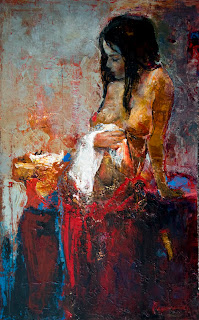March 9, 2014
February 2, 2014
July 12, 2012
April 23, 2012
March 13, 2012
December 3, 2011
November 21, 2011
November 20, 2011
March 19, 2011
February 14, 2011
August 5, 2010
July 1, 2010
New works from Nina Reznichenko

landscape with boats,Oil on canvas,70x90 cm,oil on canvas,2010

Flowers,Oil on canvas,60x80 cm,2010

Roses,Oil on canvas,80x100 cm,2010
June 24, 2010
Concealed Neuroanatomy in Michelangelo's Separation of Light From Darkness in the Sistine Chapel
Neurosurgery:
May 2010 - Volume 66 - Issue 5 - p 851–861
doi: 10.1227/01.NEU.0000368101.34523.E1
Legacy-Institutions and People: Editor's Choice
Concealed Neuroanatomy in Michelangelo's Separation of Light From Darkness in the Sistine Chapel
Suk, Ian BSc, BMC; Tamargo, Rafael J. MD, FACS
Collapse Box
Abstract
Michelangelo Buonarroti (1475–1564) was a master anatomist as well as an artistic genius. He dissected cadavers numerous times and developed a profound understanding of human anatomy. From 1508 to 1512, Michelangelo painted the ceiling of the Sistine Chapel in Rome. His Sistine Chapel frescoes are considered one of the monumental achievements of Renaissance art. In the winter of 1511, Michelangelo entered the final stages of the Sistine Chapel project and painted 4 frescoes along the longitudinal apex of the vault, which completed a series of 9 central panels depicting scenes from the Book of Genesis. It is reported that Michelangelo concealed an image of the brain in the first of these last 4 panels, namely, the Creation of Adam. Here we present evidence that he concealed another neuronanatomic structure in the final panel of this series, the Separation of Light From Darkness, specifically a ventral view of the brainstem. The Separation of Light From Darkness is an important panel in the Sistine Chapel iconography because it depicts the beginning of Creation and is located directly above the altar. We propose that Michelangelo, a deeply religious man and an accomplished anatomist, intended to enhance the meaning of this iconographically critical panel and possibly document his anatomic accomplishments by concealing this sophisticated neuroanatomic rendering within the image of God.
May 2010 - Volume 66 - Issue 5 - p 851–861
doi: 10.1227/01.NEU.0000368101.34523.E1
Legacy-Institutions and People: Editor's Choice
Concealed Neuroanatomy in Michelangelo's Separation of Light From Darkness in the Sistine Chapel
Suk, Ian BSc, BMC; Tamargo, Rafael J. MD, FACS
Collapse Box
Abstract
Michelangelo Buonarroti (1475–1564) was a master anatomist as well as an artistic genius. He dissected cadavers numerous times and developed a profound understanding of human anatomy. From 1508 to 1512, Michelangelo painted the ceiling of the Sistine Chapel in Rome. His Sistine Chapel frescoes are considered one of the monumental achievements of Renaissance art. In the winter of 1511, Michelangelo entered the final stages of the Sistine Chapel project and painted 4 frescoes along the longitudinal apex of the vault, which completed a series of 9 central panels depicting scenes from the Book of Genesis. It is reported that Michelangelo concealed an image of the brain in the first of these last 4 panels, namely, the Creation of Adam. Here we present evidence that he concealed another neuronanatomic structure in the final panel of this series, the Separation of Light From Darkness, specifically a ventral view of the brainstem. The Separation of Light From Darkness is an important panel in the Sistine Chapel iconography because it depicts the beginning of Creation and is located directly above the altar. We propose that Michelangelo, a deeply religious man and an accomplished anatomist, intended to enhance the meaning of this iconographically critical panel and possibly document his anatomic accomplishments by concealing this sophisticated neuroanatomic rendering within the image of God.
May 29, 2010
May 27, 2010
May 20, 2010
May 15, 2010
April 24, 2010
Subscribe to:
Comments (Atom)
















































